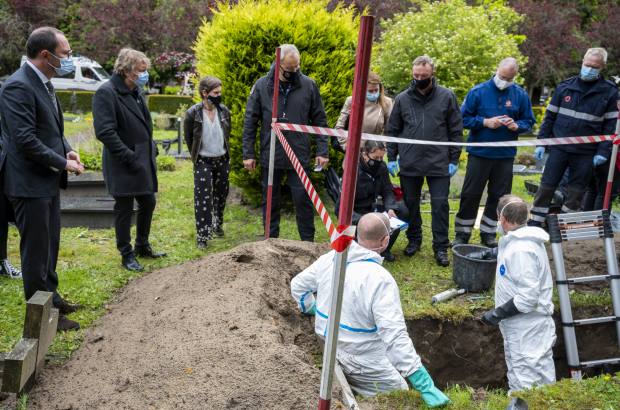- Daily & Weekly newsletters
- Buy & download The Bulletin
- Comment on our articles
"Operation Cemetery" team digs up new leads in unsolved missing persons cases
In Belgium, a total of 759 cases of disappearances are unsolved. The missing persons unit of the federal police believes the solution to solving at least some of these cases could lie with the 250 unidentified bodies buried in cemeteries throughout Belgium.
The purpose of the unit’s "Operation Cemetery" therefore is to map these bodies, to try to identify them through DNA samples and link them to missing persons cases.
The spotlight was turned on the operation during International Missing Children’s Day on Tuesday, when deputy prime minister Vincent Van Quickenborne joined the missing persons unit at the cemetery in Assebroek, near Bruges, to observe the team at work.
The unit has been working to try to identify bodies and human remains, or the identity of living people suffering from amnesia, since 1995. Since its inception, it has already solved 97% of the 29,368 missing persons cases it has handled. The unit is made up of 18 people, nine men and nine women.
Of the 29,368 disappearance cases handled, 28,609 have been resolved. In 25,177 cases, the missing people were still alive when they were found.
In 2020, the missing persons unit dealt with 785 disappearances. 745 cases were closed. In these files, 658 people were still alive at the time they were found. In other cases, the outcome was tragic, such as when the body of a 21-year-old man was found in a canal, four days after his disappearance in Vilvoorde on 1 January 2020.
Currently, 759 people are the subject of a missing person’s report. Some of these cases are old, sometimes dating back to the 1980s and remain unresolved due to a lack of recent evidence.
In order to find new clues for these unsolved cases, the unit has developed the "Cemetery" project. The aim is to systematically exhume unidentified bodies or bones from Belgian cemeteries, take a sample and establish a DNA profile. “We assume that every unidentified body is being searched for by someone,” explained commissioner Alain Remue, head of the unit. “So, if we can give a body a name, we probably also solve a disappearance."
From 1975 to the present day, 1,478 unidentified graves have been registered. Some have, in the meantime, been identified. There are still 250 bodies that remain unidentified. According to the missing persons unit, these are the bodies of 134 men, 28 women and 88 cases whose sex is not yet known.
"One of our missions is to go and list these cemeteries where we have one of these situations and then to gradually feed the information, we receive into the DNA database to make a link between unsolved missing persons files and unidentified persons," explained Commissioner David Rimaux, a member of the missing persons unit.
The genetic profile obtained from the body is entered into the DNA database of missing persons of the National Institute of Forensic and Criminology (INCC) and then compared to the DNA records in all open missing persons files.
In Bruges, where the unit was at work on Tuesday, 33 unidentified bodies are buried and awaiting the identification work of the experts.
One of the most high-profile cases of disappearance solved by the unit after exhuming a body of an unknown person is that of a Dutch national, who disappeared in 2001. This person had thrown himself under a train in the Namur region, but at the time of the incident it had not been possible to identify the person.
Papers found on the body directed the investigation to France, but without success. It was in 2018 that the missing persons unit found the solution to the riddle. "A few years ago, in Lustin Cemetery, a person who had committed suicide under a train was buried,” explained commissioner David Rimaux. “Thanks to the DNA, we were able to make a link between this person who had committed suicide and who had never been identified and the disappearance of Mrs Van der Valk, who was very well known, since she was the wife of the boss of the Van der Valk hotel chain."
Seventeen years after the event, the enigma of Corrie Van der Valk's disappearance had been solved. Her husband, Nico Van der Valk, had been imprisoned on suspicion of having killed his wife. As it turns out, that was not the case.



















